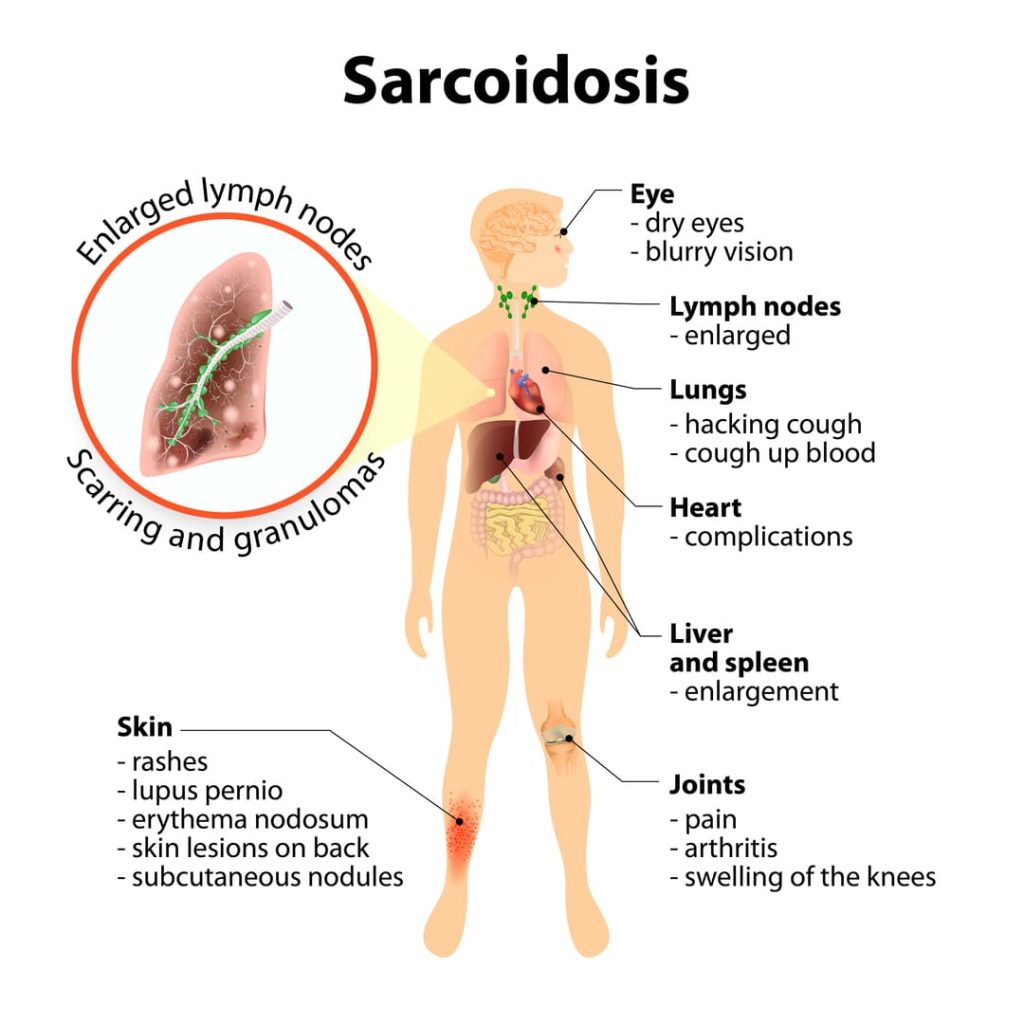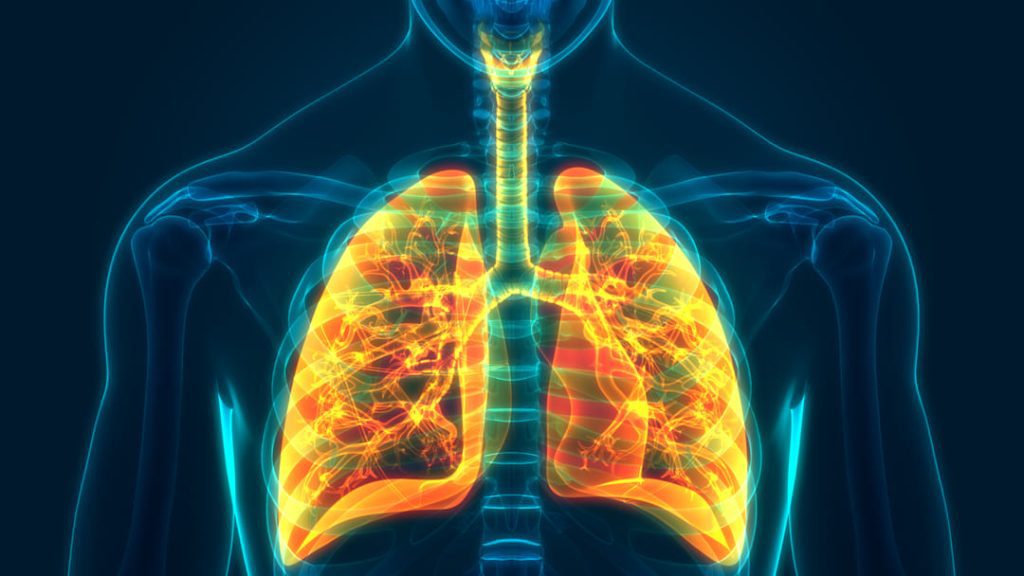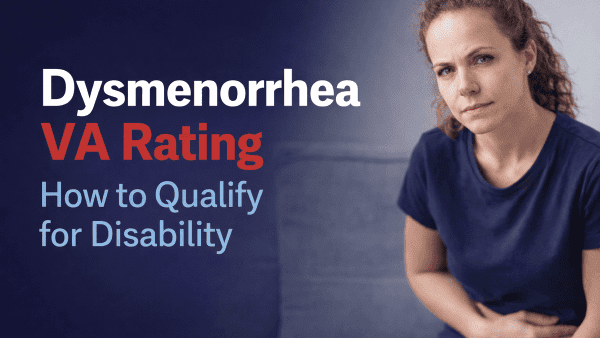Looking for Expert-Level VA Claim Answers?📱Call Us Now! 737-295-2226
If you’re a veteran diagnosed with sarcoidosis, you may be entitled to VA disability benefits—especially if you served near burn pits or experienced toxic exposures during service.
Sarcoidosis is a chronic inflammatory condition that can affect the lungs, skin, lymph nodes, and other organs. While it may resolve on its own, it can also lead to long-term complications and even become life-threatening.
In this guide, we’ll break down how the VA rates sarcoidosis, what counts as service connection (including burn pit presumptives under the PACT Act), and how to file a strong claim for benefits.
Table of Contents
Summary of Key Points
- Sarcoidosis is a chronic inflammatory disease that most often affects the lungs and can lead to serious complications—including pulmonary hypertension and organ damage—if untreated.
- Veterans can qualify for a sarcoidosis VA rating if they can prove service connection to the VA.
- Sarcoidosis VA ratings range from 0% to 100%, depending on severity, treatment needs, and respiratory or cardiac complications, and may also be rated under chronic bronchitis or organ-specific residuals.
What is Sarcoidosis?

Sarcoidosis is a disorder that causes inflammation in the body. This leads to small lumps called granulomas. It can affect any organ, but it most often affects the lungs, skin, and lymph nodes.
Sarcoidosis is believed to be caused by an overactive immune system response to an unknown trigger.
Symptoms
Symptoms can vary from person to person and range from mild to severe. Common sarcoidosis symptoms include:
- Coughing
- Shortness of breath
- Fatigue
- Weight loss
- Fever
- Night sweats
- Skin rash or lesions
- Swollen lymph nodes
There is no cure for sarcoidosis, but early diagnosis and treatment can help improve your chances of a successful outcome. Sarcoidosis is usually treated with steroids or other anti-inflammatory medications.
In some cases, sarcoidosis goes away on its own without treatment. However, sarcoidosis can also be a chronic condition that requires lifelong management.
If you think you may have sarcoidosis, see your doctor for a diagnosis.
Sarcoidosis as a VA Disability
Sarcoidosis is a VA-recognized condition, meaning that veterans diagnosed with sarcoidosis may be eligible for VA disability benefits.
Benefits may include monthly compensation payments, free health care at VA facilities, and other benefits.
To be eligible for benefits, veterans must have received a formal diagnosis from a doctor and must prove that their condition is service-connected. Sarcoidosis is a serious condition, but it is possible to live a long and healthy life with proper treatment.
Service Connection
To qualify for VA benefits, you’ll need to show that your condition is related to your military service.
To attain service connection, you must meet the 3 general requirements:
- Have a current medical diagnosis for sarcoidosis
- Have evidence of an in-service event, injury, disease, or aggravation
- Have a nexus (or link, between 1 and 2) via competent medical evidence, such as a Nexus Letter
If you were diagnosed with sarcoidosis while in service and can prove direct causation of your condition to your service, you can go for direct service connection. However, the VA has sarcoidosis in their presumptive list, where they will grant service connection even without a nexus.
Sarcoidosis is one of the chronic diseases that are subject to presumptive service connection. If it manifests to 10% or more within the first year after discharge from the military, then it’s presumed to be caused by military service.
Additionally, sarcoidosis is one of the added conditions in burn pit and other toxic exposure presumptive conditions based on the PACT Act of 2022.
Sarcoidosis VA Ratings
The VA uses these criteria to rate the severity of sarcoidosis :
- 100% – cor pulmonale, or cardiac involvement with congestive heart failure, or progressive pulmonary disease with night sweats, fever, and weight loss despite treatment
- 60% – pulmonary involvement requiring systemic high-dose (therapeutic) corticosteroids for control
- 30% – pulmonary involvement with persistent symptoms requiring chronic low-dose (maintenance) or intermittent corticosteroids
- 0% – chronic hilar adenopathy or stable lung infiltrates without symptoms or physiologic impairment
Or rate active disease or residuals as chronic bronchitis (DC 6600) and extra-pulmonary involvement under specific body system involved.
Qualifying for a Sarcoidosis VA Rating

Sarcoidosis is complex and often unpredictable, making obtaining a sarcoidosis VA disability rating difficult. However, the good news is there are several ways to qualify for benefits.
The VA will consider several factors when determining your disability rating, including the severity of your symptoms and how they affect your ability to function. The VA will also look at your medical records and any other evidence you can provide to support your claim.
Generally, the higher your disability rating, the more benefits you will be entitled to receive.
You will likely be eligible for a VA disability rating for sarcoidosis if you meet the criteria.
Link Between Sarcoidosis and Burn Pits
However, because of the PACT Act of 2022, sarcoidosis is now part of the burn pit presumptive list. This means that a veteran with burn pit exposure who is diagnosed with sarcoidosis will be granted service connection on a presumptive basis.
Link Between Sarcoidosis and Agent Orange
It is believed that sarcoidosis may be linked to exposure to certain chemicals, such as those found in Agent Orange.
Agent Orange is a herbicide that was used during the Vietnam War to defoliate jungle areas. Exposure to Agent Orange has been linked to several health problems, including cancer and birth defects.
Sarcoidosis has also been reported in Vietnam veterans exposed to Agent Orange, although it is unclear if there is a causal link. Sarcoidosis is a rare disease, so it is difficult to study. However, some experts believe that sarcoidosis and Agent Orange may be linked. It is because sarcoidosis could’ve been triggered by exposure to chemicals like Agent Orange.
Unfortunately, sarcoidosis is not one of the listed conditions for which service connection may be presumed as due to Agent Orange exposure.
Lung Sarcoidosis

Sarcoidosis is a progressive pulmonary disease caused by the build-up of inflammatory cells in the lungs. The build-up of these cells can lead to chronic bronchitis and, in some cases, sarcoidosis of the lungs.
Sarcoidosis of the lungs is a serious condition that can be fatal if left untreated. Early diagnosis and treatment are essential for preventing the progression of sarcoidosis of the lungs.
Treatment options include corticosteroids, immunotherapy, and surgery.
In some cases, sarcoidosis of the lungs may resolve on its own without treatment. However, sarcoidosis of the lungs is a serious condition that can cause breathing difficulties and death.
Conclusion
Sarcoidosis can have a significant impact on a veteran’s health, from persistent fatigue and respiratory issues to life-altering complications. If you developed sarcoidosis during or after your military service, especially if you were exposed to burn pits or other airborne hazards, you may qualify for VA disability benefits. Don’t let this complex condition go unrecognized. With the right evidence and support, you can file a successful claim and receive the compensation you deserve.
Tired of Fighting the VA Alone? WE GOT YOUR SIX!
- VA Claims Insider is the #1 most trusted name in VA disability claims.
- Work directly with a VA claims coach who can educate you to VA claim victory.
- 25,000+ disabled veterans have served in our membership programs since 2016.
- 30% average rating increase for veterans who complete our #1-rated Elite program.
- 4.7/5.0 average rating out of 5,500+ total reviews; over 4,500 5-star reviews.
FAQs | Frequently Asked Questions
Is sarcoidosis a presumptive condition for burn pit exposure?
Yes. As of the 2022 PACT Act, sarcoidosis is considered a presumptive condition for veterans exposed to burn pits or other toxic substances.
Can I get VA disability for sarcoidosis if it showed up years after service?
Possibly. Sarcoidosis qualifies for presumptive service connection if symptoms appear to a compensable degree within one year of discharge. For cases outside that window, you’ll need strong medical evidence (like a Nexus Letter) linking it to service.
How does the VA rate sarcoidosis with other conditions like COPD or asthma?
If sarcoidosis causes or worsens another respiratory condition, you may qualify for a combined rating, but the VA avoids “pyramiding” and will use the diagnostic code that results in the highest evaluation.
Is sarcoidosis of the lungs fatal?
Sarcoidosis of the lungs can lead to serious complications, such as lung damage or pneumonia if left untreated. Severe lung sarcoidosis causes internal bleeding and scarring of the lung tissue.
This produces symptoms like shortness of breath, and can lead to pulmonary hypertension and even prove fatal by causing respiratory failure (in some cases).
Is sarcoidosis a severe autoimmune disease?
Sarcoidosis is an autoimmune disease, which means the body’s immune system mistakenly attacks healthy tissue. In people with sarcoidosis, the immune system produces inflammation to fight a perceived threat. This inflammation can cause damage to organs and may lead to scarring.
Is sarcoidosis considered a critical illness?
When most people think of critical illnesses, they think of life-threatening conditions like cancer or heart disease. However, many different types of illnesses can be classified as critical. One example is sarcoidosis, a condition that affects the lungs. Sarcoidosis is a relatively rare disease, but it can be quite serious – in some cases, it can lead to lung damage and even death.
The good news is that treatment for sarcoidosis has come a long way in recent years, and most patients can now manage their condition effectively. However, sarcoidosis is still considered a critical illness, as it can significantly impact the quality of life.
Is sarcoidosis a lifetime disease?
Sarcoidosis is a progressive disease that tends to worsen over time. However, the rate of progression varies greatly from person to person, and some people may experience long periods of remission (when the disease is inactive).
In addition, most people with sarcoidosis will never experience serious symptoms or complications. As a result, while there is no cure for sarcoidosis, many people can manage the disease and live relatively normal lives.
What’s the best treatment for sarcoidosis?
There is no cure for sarcoidosis, but there are treatments that can help to control the symptoms and active disease. The most effective treatment for sarcoidosis is steroids, which can help to reduce inflammation and relieve symptoms. Doctors may also recommend radiation therapy or surgery to remove affected tissue in severe cases. With treatment, most people with sarcoidosis can live normal, healthy lives.
Author

Trisha Penrod
Trisha Penrod is a former active-duty Air Force officer. As an Intelligence Officer, she led teams of analysts to apply advanced analytic skills to identify, assess, and report potential threats to U.S. forces.
Trisha attended the U.S. Air Force Academy and holds an MBA from Webster University. After receiving an honorable discharge in 2018, Trisha worked as a growth marketer and utilizes her analytic skills to help others accomplish their business goals.



